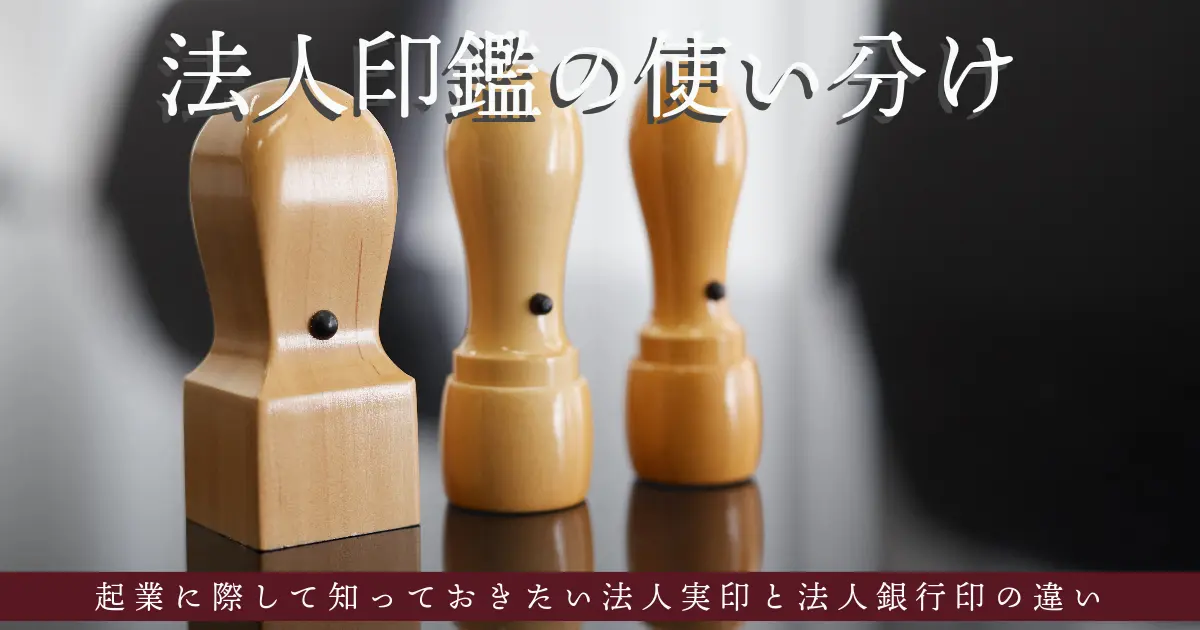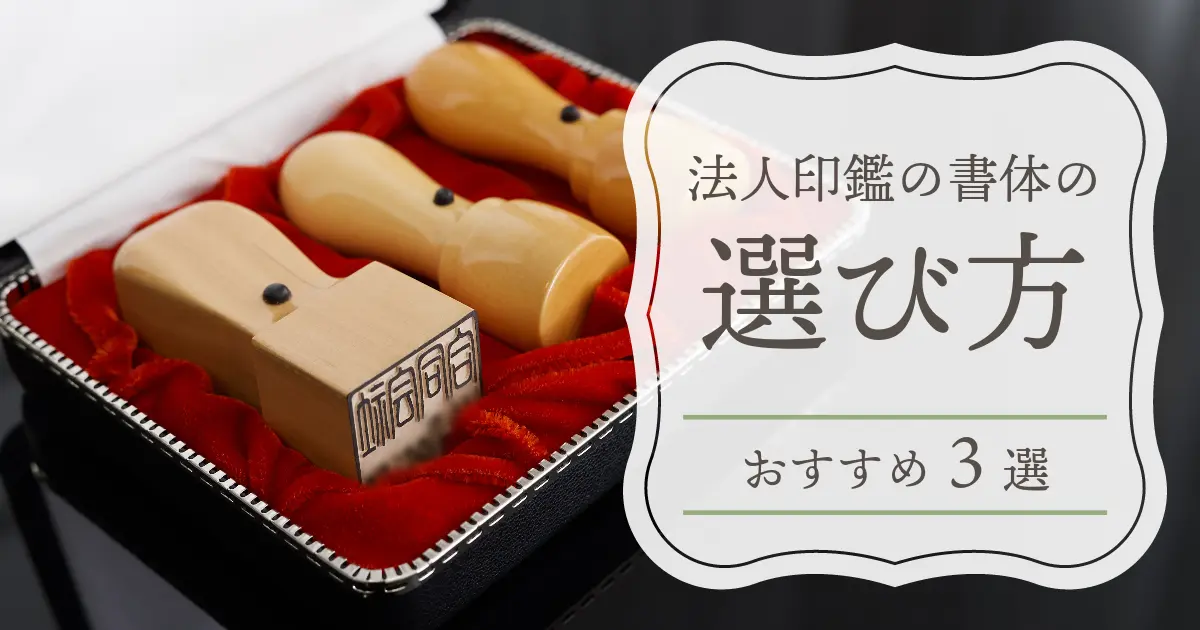In order to start a business, you need to make various preparations for establishing a company. One of these is a HANKO, and it is common to have three to four types of seals, including the representative seal that is registered as a registered seal. There may be few situations in which you are conscious of HANKO in your daily life, but it is important to understand their role in order to avoid mistakes in business contracts and important procedures. Here we will explain the types and roles of corporate HANKO, while touching on the differences between personal registered seals, bank seals, and registered seals.
HANKO and seals
To understand exactly what a HANKO is, you must know the difference between it and a stamp. When holding a stamp in your hand and applying ink to it to stamp documents, etc., the official name of the stamp, which is the tool itself, is ``insho.''
Ink is added to the seal and stamped onto paper, and the ink marks left behind are called ``in-ei'' . Originally , the impression of a seal that is registered on the documents of a government office, bank, business partner, etc. and used for verification is called a "HANKO." You can take this as trivia, but you should know that strictly speaking, a stamp is not a HANKO.
Generally, "hanko" is called "HANKO", so hereafter we will refer to it as "HANKO" to avoid confusion.
Registered seal, bank seal and registered seal
Before preparing a corporate HANKO for establishing a company, be sure to understand the types and roles of personal HANKO.
The act of stamping a HANKO means ``I acknowledge it,'' and it can be used in a variety of situations, from receiving a courier to applying for documents at city hall.
I think most people usually use a ``registered seal,'' but for important procedures, a ``registered seal'' may be required. A registered seal is a HANKO that has been registered at the municipal office and has an ``officially recognized seal impression'' engraved on it.
By notifying the HANKO you wish to use as a registered seal to the municipal office where your residence card is located and registering it, the HANKO will be legally recognized as a registered seal . If you need a HANKO certificate, go to the government office and present HANKO registration card (card) and they will issue you a certificate. In some municipalities, if you have a My Number card, you can issue one at a convenience store.
bank seal
While a registered HANKO is registered at a government office, a bank seal is a HANKO that is registered when opening a deposit account at a financial institution . Open an account by presenting HANKO for registration and a document that can verify your identity (driver's license, etc.). Since you can withdraw your deposit if you have your registered HANKO and passbook, we recommend that you keep them separately to avoid misuse if they are lost or stolen.
Seal
A personal seal is a HANKO that is not registered, such as a registered seal or a bank seal, and is used in daily life to receive parcels, etc., but if you stamp it, it means that you have acknowledged it. Legally, it may have the same effect as a registered seal, so it is prohibited to treat it lightly. Store it carefully like a registered seal or bank seal.
If you have a basic knowledge of how personal HANKO work, it will be easier to understand when preparing corporate HANKO.
Types of corporate HANKO
Corporate HANKO(also called corporate HANKO) include representative seals (corporate registered seals/office seals), corporate bank seals (company bank seals), company seals (square seals), address stamps, etc.
representative seal
A representative seal is also called a corporate registered seal or a position seal, and is a registered seal for personal HANKO . To establish a company, it must be registered at the Legal Affairs Bureau, not at the municipal office. There are strict regulations when registering, and only ``the size of the HANKO fits within a square of 1 cm or more and 3 cm'' and ``is suitable for verification'' can be registered.
As the name suggests, a representative seal is a HANKO stamped on documents submitted to government offices and important contracts as a representative of an organization. Since it proves the rights and obligations of the corporate representative, it must be managed adequately to prevent it from being taken out without permission.
Corporate bank seal
A corporate bank seal is a HANKO that a company registers when conducting current transactions with a bank . Although it is possible to use a corporate HANKO used for other purposes as a bank seal, it is better to register a dedicated bank HANKO in order to manage risks such as theft or loss.
Unlike representative seals, there are no size restrictions, but bank seals are generally made smaller to make them easier to distinguish.
Company seal/square seal
Because the shape of the stamped seal is square, it is also called a square HANKO, and for personal seals, it is considered a personal HANKO . It is not registered like a representative seal or used for opening an account like a corporate bank seal, but is used as an authentication seal on documents used by companies such as estimates, invoices, and receipts.
address stamp
A rubber stamp used for statements of delivery, receipts, etc. The stamp includes the company name, address, contact information (TEL/FAX), and the name of the representative. There are also integrated stamps and combination stamps that are used by rearranging the order, and there are also cases where ink penetrating stamps are used instead of ink.
Although there are no regulations for making address stamps, it is a convenient tool that allows information such as company name and address to be printed on various documents generated in business by simply pressing a rubber stamp, and many companies use it to improve work efficiency. It seems that.
There are several types of corporate HANKO, and if you are requesting a shop specializing in HANKO, we recommend that you also consult with them about company seals (square stamps) and address stamps (rubber stamps).
HANKO size and stamp material (material)
Each type of HANKO has an appropriate size, and each type of seal (material) has its own characteristics.
Corporate HANKO size
When registering a representative seal (corporate seal/office seal) with the Legal Affairs Bureau, there is a regulation that the size of the HANKO must fit within a square of 10 mm or more and 30 mm or less , and the general size of the seal is 18 mm . There are no size regulations for corporate bank seals, but 16.5 mm is generally smaller than the representative seal.
The size varies depending on the number of characters in the company name , so as a guideline, the representative seal should be 18 mm to 21 mm, the corporate bank seal should be 16 mm to 18 mm, and the company seal should be 21 mm to 24 mm. Different sizes are used to differentiate between company seals (square seals), representative seals, and corporate bank seals. The most common combination is a representative seal (18 mm), a corporate bank seal (16.5 mm), and a company seal (24 mm) .
In addition, it would be better if the representative seal and the corporate bank seal could be differentiated intuitively by dividing them into two types: a round bar type and a round type, so that they could be differentiated intuitively by changing not only the size but also the shape. It will be better managed.
In Hanko Shop 21's corporate establishment HANKO HANKO set, the registered seal is made with a ten-maru stamp, and the bank seal is made with a round stick.
Stamp material (material) for corporate HANKO
The main types of seal materials (materials for HANKO) are as follows.
Genuine ivory
It is a top-quality HANKO material that is so rare and famous that it is called the "king of stamp materials." The elegant color unique to ivory exudes a sense of style, and the exquisite feel and weight when held make it ideal for printing materials. Best of all, the ink ink has good adsorption properties, so when stamped, the impression is clear and beautiful, and it is highly durable, so it can be used as a HANKO for a lifetime, and is especially suitable for registered seals and bank seals.
Due to its high rarity value, the price can vary greatly depending on the retailer, and the price ranges from several thousand yen to tens of thousands of yen, depending on the part of the ivory.
dutch buffalo
It is particularly hard and sticky among water buffalo varieties, and is known as an excellent stamping material. It is called Dutch water buffalo because of its history of being exported from the Netherlands, but today stamps are made from the horns of land cattle from Australia and Africa . In addition to being used as a stamp material, it is also used around the world as a material for clothing buttons and combs.
Dutch water buffalo stamp materials are further divided into ranks, and the fewer "fu" (a mottled pattern with brown lines) the higher the rank, and the stamp material with no "fu" at all is of the highest rank and is called "White Dutch buffalo". being treated.
Black buffalo/natural black buffalo
Like Dutch buffalo, this stamp material is made from buffalo horns and is durable enough to withstand long-term use. There are also black buffalo stamp materials that are dyed black, but natural black buffalo are also called "non-dyed" and are made from high-quality parts that do not need to be dyed, and compared to black buffalo, they have a faint pattern on the surface. Like Dutch buffalo, they are distinguished by whether they have ribs or not, into "natural black buffalo" and "striped natural black buffalo".
Because of its luxurious feel, it is often used for official seals and bank seals, and because it is more affordable than ivory, it is a popular seal material.
Mototsuge・柘(Akane)
Japanese boxwood is the hardest wood material and has beautiful grain , so it has been used for combs and shogi pieces since ancient times. Boxwood from Japan, mainly Kagoshima, is whiter and has finer grain than that from Southeast Asia, making it a more luxurious product. It is easy to stamp on and is a familiar material.
This is a seal material that becomes more lustrous and beautiful the more you use it, and it is easy to print with.If you take care of it by wiping off the red ink properly after use, you can use it for a long time.
``Tsuma'', which is mainly imported from Southeast Asia, is also called ``Akane''. It has been used as a plant-based stamp material for a long time, and because of its high fiber density, it is hard and has just the right amount of stickiness compared to other woods.
titanium 44
Titanium, a rare metal, is a popular HANKO material recently. Although it is a rare metal, there are abundant reserves, so there are no resource problems, but because it is difficult to manufacture, it is said to be rare as there is little distribution. Because it is light, rust-resistant, and unlikely to cause metal allergies, it is used in medical supplies, automobile parts, and daily necessities, and is also attracting attention as a printing material.
Since titanium has ultra-fine particles, it blends well with ink and creates beautiful stamps with no unevenness. It has a moderate weight so it is easy to stamp, and it is durable and can be used for many years . It is so safe that it is used in medical devices such as dentists' artificial tooth roots (implants) and cardiac pacemakers, and there is no need to worry about metal allergies, so even those with sensitive skin can use it with confidence.
summary
Above, we have delved into the meaning of stamps and HANKO, and explained the types and roles of personal HANKO, and then explained corporate HANKO. Especially when it comes to representative company seals and corporate bank seals, the appearance of the seal and the beauty of the seal impression when affixed have an impact on the company's image. Information on the size and material of the HANKO will also be necessary when preparing a corporate HANKO. I hope this will be of some help to you when you decide to start a business and establish a company.
 日本語
日本語 English
English 简体中文
简体中文 繁體中文
繁體中文 한국어
한국어 ไทย
ไทย Tiếng Việt
Tiếng Việt Indonesia
Indonesia Français
Français Español
Español Português
Português


